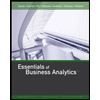
1.
Compute inherent risk.
1.
Answer to Problem 27BEB
Inherent risk is $400,000.
Explanation of Solution
Inherent Risk:
Inherent risk is a risk that prevails in a system before any control measure is adopted within an organization.
Computation of inherent risk:
Inherent risk can be computed by using the following formula:
Substitute $1,000,000 for impact and 40% for the probability of occurrence in the above formula.
Therefore, inherent risk is $400,000.
2.
Compute residual risk of each of the three alternatives.
2.
Answer to Problem 27BEB
Residual risk for alternative A, B, and C is $48,750, $105,000, and $400,000respectively.
Explanation of Solution
Residual risk can be computed by using the following formula:
Computation of residual risk for alternative A:
Substitute $325,000 for impact and 15% for the probability of occurrence in the above formula.
Computation of residual risk for alternative B:
Substitute $300,000 for impact and 35% for the probability of occurrence in the above formula.
Computation of residual risk for alternative C:
Substitute $1,000,000 for impact and 40% for the probability of occurrence in the above formula.
Therefore, residual risk for alternative A, B, and C is $48,750, $105,000, and $400,000 respectively.
3.
Compute benefit from each of the three alternatives.
3.
Answer to Problem 27BEB
Benefit from alternatives A, B, and C is $351,250, $295,000, and $0 respectively.
Explanation of Solution
Benefit from a risk response alternative can be computed by using the following formula:
Computation of response benefit from alternative A:
Substitute $400,000 for inherent risk and $48,750 for residual risk in the above formula.
Computation of response benefit from alternative B:
Substitute $400,000for inherent risk and $105,000 for residual risk in the above formula.
Computation of response benefit from alternative C:
Substitute $400,000for inherent risk and $400,000 for residual risk in the above formula.
Therefore, benefit from alternatives A, B, and C is $351,250, $295,000, and $0 respectively.
4.
Compute net benefit from each of the three alternatives.
4.
Answer to Problem 27BEB
Net benefit from alternatives A, B, and C is $150,000, $100,000, and $0 respectively.
Explanation of Solution
Net benefit from a risk response alternative can be computed by using the following formula:
Computation of net benefit from alternative A:
Substitute $351,250 for response benefit and $201,250 for response cost in the above formula:
Computation of net benefit from alternative B:
Substitute $295,000 for response benefit and $195,000 for response cost in the above formula:
Computation of net benefit from alternative C:
Substitute $0 for response benefit and $0 for response cost in the above formula:
Therefore, net benefit from alternatives A, B, and C is $150,000, $100,000, and $0 respectively.
5.
Identify the alternative which would be adopted by the company.
5.
Explanation of Solution
Alternative A would be chosen by the company since; net benefit is highest in case of alternative A.
Want to see more full solutions like this?
Chapter 13 Solutions
Managerial Accounting
- Please explain the solution to this general accounting problem with accurate principles.arrow_forwardSteel Manufacturing uses a job order costing system. During one month, Steel purchased $188,000 of raw materials on credit; issued materials to the production of $215,000 of which $10,000 were indirect. Steel incurred a factory payroll of $159,000, of which $20,000 was indirect labor. Steel uses a predetermined overhead rate of 150% of direct labor cost. The total manufacturing costs added during the period are___.arrow_forwardFinancial Accountingarrow_forward
 Managerial Accounting: The Cornerstone of Busines...AccountingISBN:9781337115773Author:Maryanne M. Mowen, Don R. Hansen, Dan L. HeitgerPublisher:Cengage Learning
Managerial Accounting: The Cornerstone of Busines...AccountingISBN:9781337115773Author:Maryanne M. Mowen, Don R. Hansen, Dan L. HeitgerPublisher:Cengage Learning Essentials of Business Analytics (MindTap Course ...StatisticsISBN:9781305627734Author:Jeffrey D. Camm, James J. Cochran, Michael J. Fry, Jeffrey W. Ohlmann, David R. AndersonPublisher:Cengage Learning
Essentials of Business Analytics (MindTap Course ...StatisticsISBN:9781305627734Author:Jeffrey D. Camm, James J. Cochran, Michael J. Fry, Jeffrey W. Ohlmann, David R. AndersonPublisher:Cengage Learning

